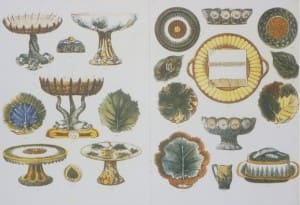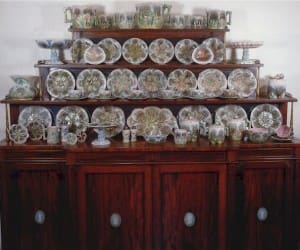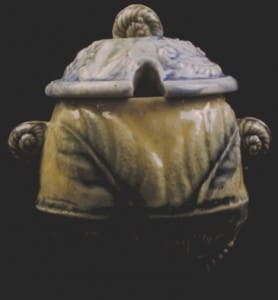A presentation given to the National Academy of Design
January 16, 2004
by Marilyn G. Karmason, M.D.
Click on pictures to enlarge!
Updated: June 30, 2009
Section 7: American
As for American Majolica: Griffen, Smith and Hill, or Etruscan, were from Phoenixville, PA, 1879. In 1884-5 the company attended a New Orleans exhibition, honored for their majolica. Here are 2 pages of the catalogue that include 150 pieces of Majolica with the Shell and Seaweed pattern.
An Etruscan ice cream platter has great shell-and-seaweed.
As does a larger compote and tea service.
The next slide shows almost all pieces of the Shell and Seaweed design, from the tiny butter pat on the left.
The large humidor
and Tea Service shown here alone.
Here is a Cheese Bell and Sardine Box, and a Paperweight.
Here is a beautiful Etruscan napkin plate.
This Etruscan Oyster Plate reached no less than $6,000 at auction.
Small note: In 1880, Tenuous Majolica, the primitive version of Etruscan, was attributed to William Hill of Griffen, Smith and Hill. But in recent years, it turns out that this attribution was as “tenuous” as its name when it became known that Tenuous came from a Richard Harrison, in 1882-1887, inPeekskill, NY. Here is Harrison’s covered mustard pot.
There are about a dozen other makers of American majolica, George Morely in East Liverpool and Wellsville, Ohio, produced owl pitchers and gurgling-fish pitchers, colors not bright.
But cheerful David Haynes owned the Baltimore Chesapeake Pottery in 1882. He produced majolica, as a Clifton dinner service, and later as Avalon clocks and banks. In the early 2Oth century, Haynes’ majolica was sold at Macy‘s.
The Eureka Pottery, established in 1883 in Trenton, N.J. was inspired by English interpretations of Oriental design. This Fan-shaped ice cream server with colorful figures on a pebbly blue background is very similar to the Wedgwood Bird & Fan.













